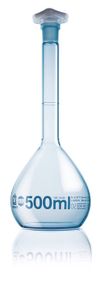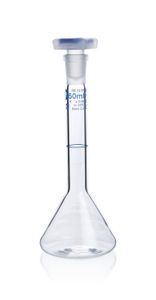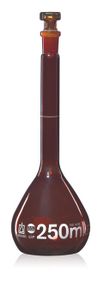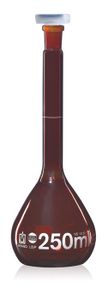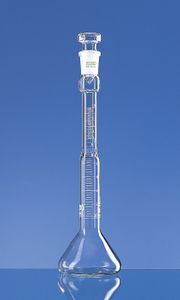What kind of screening inks does BRAND use for printing the volumetric flasks?
Blue and white enamel are printed on the outer surface and provide a high contrast and an optimal combination of chemical resistance and legibility for BLAUBRAND (cl. A) and SILBERBRAND (cl. B) volumetric flasks.
Amber diffusion stain is used for BLAUBRAND®-ETERNA (cl. A) and SILBERBRAND-ETERNA (cl. B) volumetric flasks. This color diffuses into the glass surface and can therefore only be removed by abrasion or glass corrosion.
For what kind of application are volumetric flasks with 3 marks useful?
The volumetric flask with 3 marks is used to check the functioning of a dispenser. The mark in the middle shows the nominal volume, the upper and lower marks show the error limit. If the error limit is exceeded even with repeated measurements, the dispenser is defective.
What kind of special volumetric flasks do BRAND offer?
BRAND offers special volumetric flasks for Kohlrausch sugar analysis and oil content determination in accordance to DIN 51368. Both are made of high quality borosilicate glass 3.3.
What is the difference between Class A and Class B?
Class A stands for highest quality grade volumetric flasks in accordance to DIN EN ISO 1042 and, therefore, for tight error limits (BLAUBRAND®).
Class B volumetric flasks (SILBERBRAND) have larger error limits than Class A volumetric flasks, usually twice as much.
Is it better to use a PP stopper instead of a glass stopper?
Usually PP stoppers are cheaper than glass stoppers, but glass stoppers can resist more chemicals. For instance, PP reacts with highly concentrated nitric or sulfuric acid and is therefore not suitable as stopper, while glass shows no reaction with these chemcials. Hence, it depends on the application you want to use the volumetric flasks for.
What advantages do PURprotect volumetric flasks have?
In the event of breakage, the safety polyurethane-coating helps to contain the glass fragments. Compared to uncoated glass flasks the electrostatic charge is not increased.
What is the difference between Class A and AW and Class B and BW, respectively?
The extension 'W' refers to wide neck as these flasks contain necks with larger inner diameters and thus larger neck sizes. In accordance to DIN EN ISO 1042 these wide neck flasks have to be marked with extension 'W' as the error limits of these flasks are a bit higher compared to normal or narrow neck flasks.
What advantages do amber volumetric flasks have?
Amber bulb-shaped flasks preserve light-sensitive chemical solutions from UV radiation. The chemical solution only comes into contact with borosilicate glass 3.3 and not with the amber stain. BLAUBRAND® amber flasks are made by diffusion of amber stain into the outer surface of clear glass.
What advantages do trapezoidal measuring flasks have?
Small capacity standard volumetric flasks can tip over more easily due to their higher center of gravity. Trapezoidal measuring flasks have a much larger base area which greatly improves stability.



